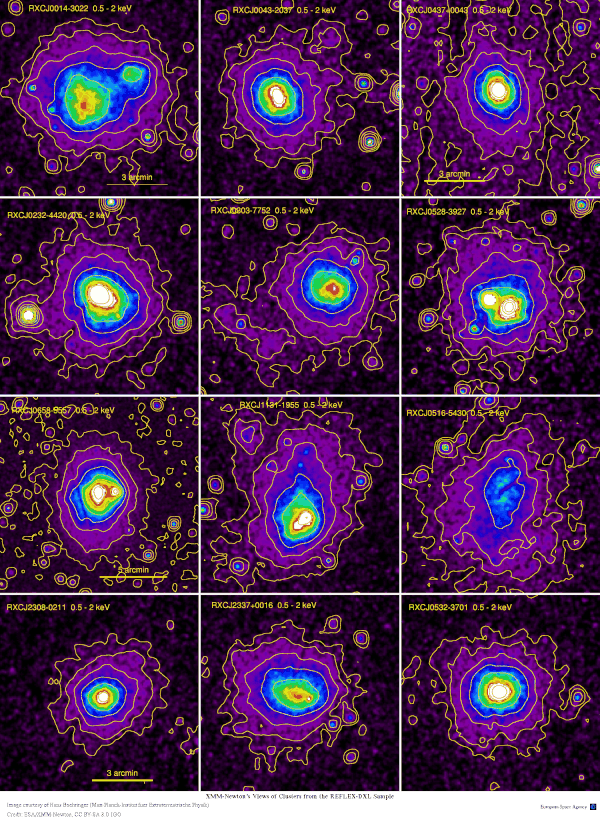XMM-Newton's Views of Clusters from the REFLEX-DXL Sample

Minimum credit line: Image courtesy of Hans Boehringer (Max-Planck-Institut fuer Extraterrestrische Physik) and ESA. (for details, see Conditions of Use).
Credit: ESA/XMM-Newton, CC BY-SA 3.0 IGO
The image above can be displayed at full size and may be downloaded by clicking the image above.
| About this Image |
|---|
XMM-Newton's EPIC cameras' views of REFLEX-DXL galaxy clusters, with contours superimposed. The investigators composed a sample of distant, X-ray luminous galaxy clusters in the redshift range z=0.26 to 0.31, with X-ray luminosities greater than 1.e+45 erg/s for the 0.1-2.4 keV band (the REFLEX-DXL sample) to investigate the scaling relations of massive galaxy clusters. The panels shows merged images from the MOS1, MOS2 and pn cameras of the clusters as seen in the 0.5-2 keV energy band. The cosmic evolution of large-scale structure (LSS) can be probed using the number density of clusters of galaxies, and hence studies of number density can be used to test cosmological models. The largest clusters are anticipated to demonstrate the largest evolutionary effects and therefore are particularly important in tracing LSS evolution. Since the REFLEX-DXL cluster galaxies are X-ray luminous they can be inferred to be very massive. The structure of the X-ray emitting intracluster plasma depends primarily on gravitational effects and shock heating for the most massive clusters (this dependence weakens as cluster mass decreases). Therefore hierarchical modelling should describe more massive clusters better, making them the most useful for comparisons of observations with theory.
Investigator(s): H. Boehringer, Y.-Y. Zhang, A. Finoguenov, Y. Ikebe, K. Matsushita, P. Schuecker, L. Guzzo, C. A. Collins
| For More Information |
|---|
- Read the Journal article
- Visit related website;
http://adsabs.harvard.edu/cgi-bin/nph-bib_query?bibcode=2006A%26A...456...55Z&am - Detailed description of this image
- For unfamiliar terms, visit the XMM-Newton Astronomical Glossary
| Instrument | EPIC | ||
| Observing Mode | N/A | ||
| Filter | Thin | ||
| Date of Observation | 2002-10-07 | ||
| Band (lo - hi) | 0.5 - 2.0 keV | ||
| Image size | 12.00 x 12.00 arcmin | ||
| Detailed Caption | Several properties of the clusters have since been studied such as temperature distributions, cluster masses and gas fractions and luminosity, and scaling relations between some of these parameters. See the references for more detail on the scientific results derived from the observations. The clusters were observed during 2001-2002, for of the order of 10ks each with the EPIC MOS1, MOS2 and pn cameras using thin filters. The MOS cameras were operated in full frame mode and the pn in full frame or extended full frame mode. | ||
| Alternate Resolutions | (Help) |
|---|
This image is available in the following downloadable versions: Higher resolution versions of this image may be available, please contact the XMM-Newton HelpDesk.
Search the Image Gallery
To search the Image Gallery for a particular object, fill in the object name in the box below and click the Submit button.To search the Image Gallery for other images, fill in any of the fields below and click the Submit button.
For more search options, please use our Advanced Search form.